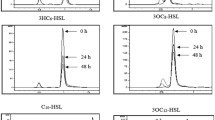Abstract
One hundred and forty-two Bradyrhizobium strains were screened for their ability to produce N-acyl homoserine lactone-like molecules (AHLs) by using an Agrobacterium tumefaciens biosensor strain containing a traI-lacZ fusion. Approximately 22% (31 of 142) of the tested strains produced AHLs that induced moderate to elevated β-galactosidase activity levels in the biosensor strain. Bradyrhizobium japonicum and Bradyrhizobium elkanii strains were both shown to produce AHLs. Age of culture, and media composition were each shown to influence production of AHL(s), with greater production occurring in 2 day-old cultures grown in rich media. Reverse-phase high-performance liquid chromatography and thin-layer chromatography analyses indicated that the B. japonicum strain USDA 290 produced at least two types of AHLs. Our results indicate that the production AHL-like autoinducers is widespread among both B. japonicum and B. elkanii strains.


Similar content being viewed by others
Literature Cited
Bergersen FJ (1961) Growth of Rhizobium on synthetic medium Aust J Biol Sci 14:349–360
Bishop PE, Guevara JG, Engelka JA, Evans HJ (1976) Relation between glutamine synthetase and nitrogenase activities in the symbiotic association between Rhizobium japonicum and Glycine max Plant Physiol 57:542–546
Cha C, Gao P, Chen Y-C, Shaw PD, Farrand SK (1998) Production of acyl-homoserine lactone quorum-sensing signals by gram-negative plant-associated bacteria Mol Plant-Microbe Interact 11:1119–1129
Daniels R, De Vos DE, Desair J, Raedschelders G, Luyten E, Rosemeyer V, et al. (2001) The cin quorum sensing locus of Rhizobium etli CNPAF512 affects growth and symbiotic nitrogen fixation J Biol Chem 277:462–468
Daniels R, Vanderleyden J, Michiels J (2004) Quorum sensing and swarming migration in bacteria FEMS Microbiol Rev 28:261–289
Dunny GM, Winans SC (1999) Cell-cell signaling in bacteria. Washington, DC: ASM Press
Fuqua WC, Winans SC, Greenberg EP (1994) Quorum sensing in bacteria: the LuxR-LuxI family of cell density-responsive transcriptional regulators J Bacteriol 176:269–275
Fuqua C, Winans SC (1996) Conserved cis-acting promoter elements are required for density-dependent transcription of Agrobacterium tumefaciens conjugal transfer genes J Bacteriol 178:435–440
Fuqua WC, Winans SC, Greenberg EP (1996) Census and consensus in bacterial ecosystems: the LuxR-LuxI family of quorum sensing transcriptional regulators Annu Rev Microbiol 50:727–751
Gonzalez JE, Marketon MM (2003) Quorum sensing in nitrogen-fixing rhizobia Microbiol Mol Biol Rev 67:574–592
Greenberg EP (2000) Acyl-homoserine lactone quorum sensing in bacteria J Microbiol 38:117–121
He X, Chang W, Pierce DL, Seib LO, Wagner J, Fuqua C (2003) Quorum sensing in Rhizobium sp. strain NGR234 regulates conjugal transfer (tra) gene expression and influences growth rate J Bacteriol 185:809–822
Loh J, Yuen-Tsai JP, Stacey MG, Lohar D, Welborn A, Stacey G (2001) Population density-dependent regulation of the Bradyrhizobium japonicum nodulation genes Mol Microbiol 42:37–46
Loh J, Carlson RW, York WS, Stacey G (2002a) Bradyoxetin, a unique chemical signal involved in symbiotic gene regulation Proc Natl Acad Sci USA 99:14446–14451
Loh J, Lohar DP, Andersen B, Stacey G (2002b) A two-component regulator mediates population-density-dependent expression of the Bradyrhizobium japonicum nodulation genes J Bacteriol 184:1759–1766
Lohrke SM, Madrzak CJ, Hur H-G, Judd AK, Orf JH, Sadowsky MJ (2000) Inoculum density-dependent restriction of nodulation in the soybean―Bradyrhizobium japonicum symbiosis. Symbiosis 29:59–70
Marketon MM, González JE (2002) Identification of two quorum-sensing systems in Sinorhizobium meliloti J Bacteriol 184:3466–3475
Miller JH (1972) Experiments in molecular genetics. New York: Cold Spring Harbor Laboratory Press
Miller MB, Bassler BL (2001) Quorum sensing in bacteria Annu Rev Microbiol 55:165–199
Parsek MR, Greenberg EP (2000) Acyl-homoserine lactone quorum sensing in gram-negative bacteria: A signaling mechanism involved in associations with higher organisms Proc Natl Acad Sci USA 97:8789–8793
Pongsilp N, Teaumroong N, Nuntagij A, Boonkerd N, Sadowsky MJ (2002) Genetic structure of indigenous non-nodulating and nodulating populations of Bradyrhizobium in soils from Thailand Symbiosis 33:39–58
Rosemeyer V, Michiels J, Verreth C, Vanderleyden J (1998) luxI- and luxR-homologous genes of Rhizobium etli CNPAF512 contribute to synthesis of autoinducer molecules and nodulation of Phaseolus vulgaris J Bacteriol 180:815–821
Sadowsky MJ, Tully RE, Cregan PB, Keyser HH (1987) Genetic diversity in Bradyrhizobium japonicum serogroup 123 and relation to genotype specific nodulation of soybean Appl Environ Microbiol 53:2624–2630
Shaw PD, Ping G, Daly SL, Cha C, Cronan JE Jr, Rinehart KL, et al. (1997) Detecting and characterizing N-acyl-homoserine lactone signal molecules by thin-layer chromatography Proc Natl Acad Sci USA 94:6036–6041
Takakazu K, Nakamura Y, Sato S, Minamisawa K, Uchiumi T, Sasamoto S, et al. (2002) Complete genomic sequence of nitrogen-fixing symbiotic bacterium Bradyrhizobium japonicum USDA110 DNA Res 9:189–197
Tempe J, Petit A, Holsters M, van Montagu M, Schell J (1977) Thermosensitive step associated with transfer of the Ti plasmid during conjugation: Possible relation to transformation in crown gall Proc Natl Acad Sci USA 74:2848–2849
Westenberg DJ (2002) Evidence of AHL autoinducer production by the soybean symbiont Bradyrhizobium japonicum. In: Finan T, O’Brian M, Vessey S, Newton W (eds) Nitrogen fixation: Global perspectives. Proceedings of the 13th International Congress on Nitrogen Fixation. Cambridge: CABI Publishing, p 409
Wilkinson A, Danino V, Wisniewski-Dyé F, Lithgow JK, Downie JA (2002) N-acyl-homoserine lactone inhibition of rhizobial growth is mediated by two quorum-sensing genes that regulate plasmid transfer J Bacteriol 184:4510–4519
Zhu J, Beaber JW, Moré MI, Fuqua C, Eberhard A, Winans SC (1998) Analogs of the autoinducer 3-oxooctanoyl-homoserine lactone strongly inhibit activity of the TraR protein of Agrobacterium tumefaciens J Bacteriol 180:5398–5405
Acknowledgments
This work was supported, in part, by funding from the Thailand Research Fund, the University of Wisconsin-Madison Asian Partnership fund, and The University of Minnesota Agricultural Experiment Station. We would like to thank Clay Fuqua for providing the A. tumefaciens NTL4 and KYC6 strains, Peter van Berkum for providing the USDA strain, R. Stewart Smith for Nitragin strains, Jennifer Seffernick for her help with HPLC analyses, and Carl Rosen for help with Statistics.
Author information
Authors and Affiliations
Corresponding author
Rights and permissions
About this article
Cite this article
Pongsilp, N., Triplett, E.W. & Sadowsky, M.J. Detection of Homoserine Lactone-Like Quorum Sensing Molecules in Bradyrhizobium Strains. Curr Microbiol 51, 250–254 (2005). https://doi.org/10.1007/s00284-005-4550-5
Received:
Accepted:
Published:
Issue Date:
DOI: https://doi.org/10.1007/s00284-005-4550-5




